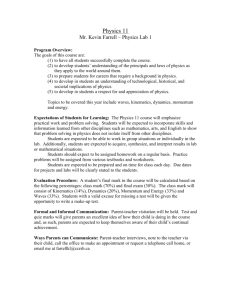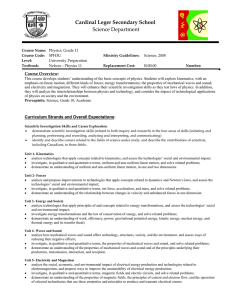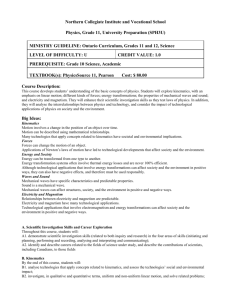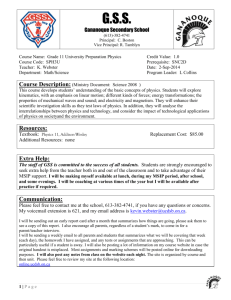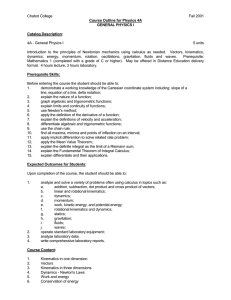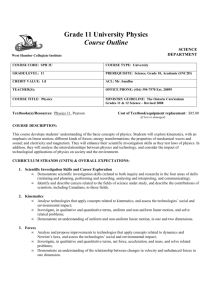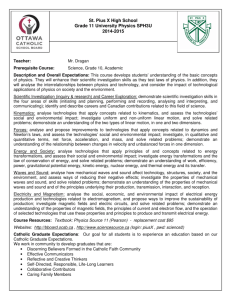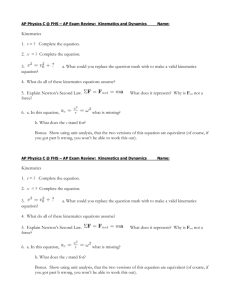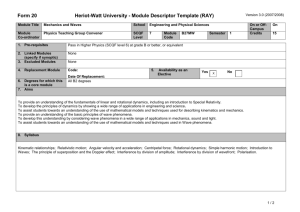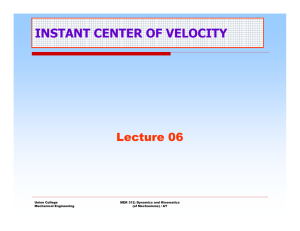SPH3U Physics Grade 11 Course Outline
advertisement
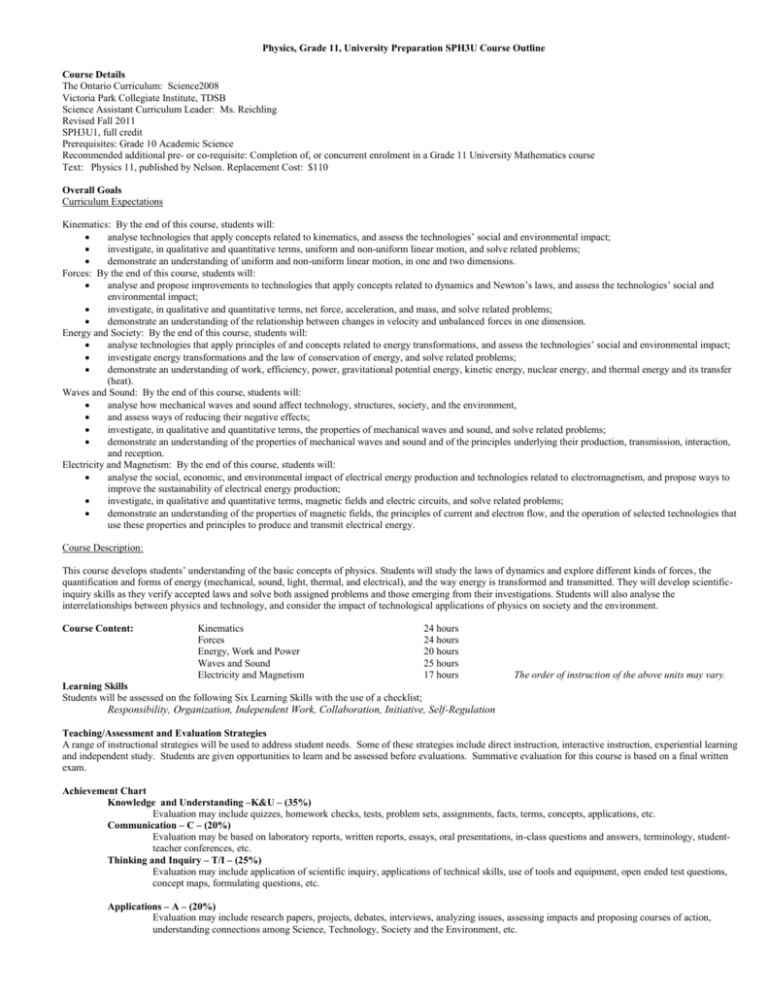
Physics, Grade 11, University Preparation SPH3U Course Outline Course Details The Ontario Curriculum: Science2008 Victoria Park Collegiate Institute, TDSB Science Assistant Curriculum Leader: Ms. Reichling Revised Fall 2011 SPH3U1, full credit Prerequisites: Grade 10 Academic Science Recommended additional pre- or co-requisite: Completion of, or concurrent enrolment in a Grade 11 University Mathematics course Text: Physics 11, published by Nelson. Replacement Cost: $110 Overall Goals Curriculum Expectations Kinematics: By the end of this course, students will: analyse technologies that apply concepts related to kinematics, and assess the technologies’ social and environmental impact; investigate, in qualitative and quantitative terms, uniform and non-uniform linear motion, and solve related problems; demonstrate an understanding of uniform and non-uniform linear motion, in one and two dimensions. Forces: By the end of this course, students will: analyse and propose improvements to technologies that apply concepts related to dynamics and Newton’s laws, and assess the technologies’ social and environmental impact; investigate, in qualitative and quantitative terms, net force, acceleration, and mass, and solve related problems; demonstrate an understanding of the relationship between changes in velocity and unbalanced forces in one dimension. Energy and Society: By the end of this course, students will: analyse technologies that apply principles of and concepts related to energy transformations, and assess the technologies’ social and environmental impact; investigate energy transformations and the law of conservation of energy, and solve related problems; demonstrate an understanding of work, efficiency, power, gravitational potential energy, kinetic energy, nuclear energy, and thermal energy and its transfer (heat). Waves and Sound: By the end of this course, students will: analyse how mechanical waves and sound affect technology, structures, society, and the environment, and assess ways of reducing their negative effects; investigate, in qualitative and quantitative terms, the properties of mechanical waves and sound, and solve related problems; demonstrate an understanding of the properties of mechanical waves and sound and of the principles underlying their production, transmission, interaction, and reception. Electricity and Magnetism: By the end of this course, students will: analyse the social, economic, and environmental impact of electrical energy production and technologies related to electromagnetism, and propose ways to improve the sustainability of electrical energy production; investigate, in qualitative and quantitative terms, magnetic fields and electric circuits, and solve related problems; demonstrate an understanding of the properties of magnetic fields, the principles of current and electron flow, and the operation of selected technologies that use these properties and principles to produce and transmit electrical energy. Course Description: This course develops students’ understanding of the basic concepts of physics. Students will study the laws of dynamics and explore different kinds of forces, the quantification and forms of energy (mechanical, sound, light, thermal, and electrical), and the way energy is transformed and transmitted. They will develop scientificinquiry skills as they verify accepted laws and solve both assigned problems and those emerging from their investigations. Students will also analyse the interrelationships between physics and technology, and consider the impact of technological applications of physics on society and the environment. Course Content: Kinematics Forces Energy, Work and Power Waves and Sound Electricity and Magnetism 24 hours 24 hours 20 hours 25 hours 17 hours The order of instruction of the above units may vary. Learning Skills Students will be assessed on the following Six Learning Skills with the use of a checklist; Responsibility, Organization, Independent Work, Collaboration, Initiative, Self-Regulation Teaching/Assessment and Evaluation Strategies A range of instructional strategies will be used to address student needs. Some of these strategies include direct instruction, interactive instruction, experiential learning and independent study. Students are given opportunities to learn and be assessed before evaluations. Summative evaluation for this course is based on a final written exam. Achievement Chart Knowledge and Understanding –K&U – (35%) Evaluation may include quizzes, homework checks, tests, problem sets, assignments, facts, terms, concepts, applications, etc. Communication – C – (20%) Evaluation may be based on laboratory reports, written reports, essays, oral presentations, in-class questions and answers, terminology, studentteacher conferences, etc. Thinking and Inquiry – T/I – (25%) Evaluation may include application of scientific inquiry, applications of technical skills, use of tools and equipment, open ended test questions, concept maps, formulating questions, etc. Applications – A – (20%) Evaluation may include research papers, projects, debates, interviews, analyzing issues, assessing impacts and proposing courses of action, understanding connections among Science, Technology, Society and the Environment, etc. 70% Grade on Course Work** Kinematics / Light and Geometric Optics Task Kinematics Assessment #1 Kinematics Assessment #2 Kinematics Activity Kinematics Lab/assignment Unit Test Forces K&U x x x Task Dynamics assessment 1 Dynamics assignment Dynamics lab/assignment Dynamics assessment 2 Unit Test K&U x Achievement Chart Focus T/I C x x x x x x x Achievement Chart Focus T/I C x x x x x x x x x A Time of Assessment x x x A Time of Assessment x x Energy, Work, and Power Task Work and Energy Assessment Power Activity Energy and Power Assessment Energy Assignment Unit Test Waves and Sound K&U x x x Achievement Chart Focus T/I C Wave Motion Assessment Speed of Sound Lab/assignment Sound Assessment Sound Activity Sound Lab/assignment Unit Test Electricity and Magnetism Task Ohm’s Law Activity Circuits Assessment Electromagnetism Lab/assignment Electromagnetism Assessment Unit Quest xx Above tasks subject to minor changes. K&U x Time of Assessment x x Task A x x x Achievement Chart Focus T/I C x x A Time of Assessment x x x x x K&U x x x x x x x x Achievement Chart Focus T/I C x x x x x x A Time of Assessment x x x x 30% Grade Based on Course-Culminating Activities All students will write a final exam at the end of the course. Term Grades for Provincial Reports throughout the Year The grade for each term/reporting period is based on the evaluations that have been conducted to that point in the course, and will be preliminary and tentative. They will be based on the most consistent level of achievement to that time, but some of the overall expectations, strands, end units, will not have been addressed. The students’ grades may change when all work has been evaluated at the end of the course. Midterm reports will be sent home with the students approximately half way through the semester. The Research Process: For every research-based assignment, students will be expected to use the TDSB student research guide, Research @ Your Library with the 4 stage model of the research process incorporated into these assignments either in part or in whole. Students will receive instruction and be assessed / evaluated on various aspects of the research process by either their teacher or one of the teacher-librarians. These lessons may include, but are not limited to the development of research questions, note-taking, adherence to a specific documentation style, facility with a variety of resources, etc. Accommodations Accommodations refer to the teaching strategies, supports, and/or services that are required in order for a student to access the curriculum and demonstrate learning. Students who have an IEP are entitled to the accommodations specified in their plans. Communication First of all … KNOW that we want you to succeed. The science office is in room 221. You are encouraged to make an appointment with your teacher if you would like extra help, or if you wish to see/discuss your marks. Do not hesitate to ask for help. Parents/guardians may contact the teacher at any time with comments and/or concerns at 416 – 395 – 3310 ext. 20095. Parents/guardians may also schedule an interview during Parent/Teacher interview time. The teacher will contact parents/guardians as necessary.
